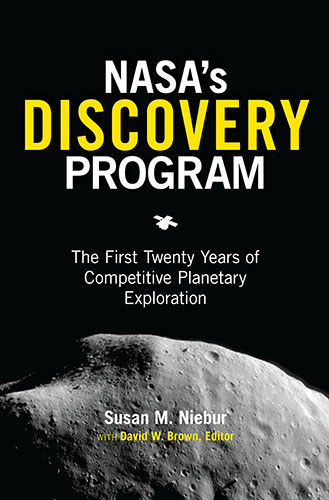Category: Nonfiction
Reviewed by: Casey Suire
Title: NASA’s Discovery Program: The First Twenty Years of Competitive Planetary Exploration
Author: Susan Niebur, with David W. Brown
Format: Hardcover/Paperback/Kindle/free PDF from NASA
Pages: 444
Publisher: NASA History Division
Date: January 2024
Retail price: $55.08/$13.06/$0.99/Free
ISBN: 979-8876271341
Last October, NASA’s Psyche spacecraft departed Earth. After a gravity assist from Mars in 2026, this robotic explorer is expected to reach its destination, the metallic asteroid 16 Psyche, in August 2029. Psyche is the latest mission in NASA’s Discovery program, a series of small and relatively inexpensive robotic space missions focused on exploring planets and small solar system bodies.
This book, produced by NASA’s History Division, details the first two decades of the Discovery program. Unlike big-budget Flagship-class space missions like Viking, Voyager, and Galileo, Discovery missions were conceived as a frequent and lower-cost way to do planetary science. Initially, the cost of each Discovery mission, excluding the launch vehicle, was limited to $150 million (in 1992 dollars). This was perfect for the “faster, better, cheaper” Goldin-era NASA of the 1990s. At one point, personnel in the program proclaimed, “We wanted to show that for the cost of a typical Hollywood movie, you can explore interplanetary space.” Eventually, however, setbacks with the Discovery program in the early 2000s, coupled with the much publicized failures of the non-Discovery Mars Climate Orbiter and Mars Polar Lander missions, resulted in changes that made future Discovery missions rise in cost.
In the book’s forward, the Discovery program is described as “the most important NASA robotic planetary spacecraft program you have never heard of—unless you are a space agency insider.” This assessment perfectly sums up the program. The book will teach you a lot about the Discovery program’s quest to unlock the secrets of our solar system. Even if you’re a die-hard NASA fan familiar with the Discovery missions, you’re likely to learn something new. There are plenty of behind-the-scenes stories by those involved in the program. This is a great thing, as the contributions of key people involved with the Discovery missions, such as Wesley Huntress and Tom Krimigis, are not very well known compared with those from other areas of space exploration. With this book, these relatively unknown figures get their due.
There are inconsistencies with how much coverage each Discovery mission gets in the book. Noticeably, the first three missions, Mars Pathfinder, NEAR Shoemaker, and Lunar Prospector, only get a few pages of attention. Many interesting facts from this trio of missions were not mentioned. For example, Mars Pathfinder’s Independence Day 1997 landing on the Red Planet was a massive Internet event. The mission had 566 million total Internet hits, including 47 million during one day. This incredible display of public admiration and support for the space program was not included in the book. Furthermore, the Near Earth Asteroid Rendezvous (NEAR) mission was renamed NEAR Shoemaker following the death of famed geologist Gene Shoemaker. During the Apollo program, Shoemaker helped train the astronauts. Some of his ashes were sent to the Moon aboard Lunar Prospector. This story was also excluded from the book. Subsequent missions are covered in much greater detail: Stardust, Genesis, CONTOUR, MESSENGER, Deep Impact, Dawn, and Kepler.
Overall, the book is written in such a way that readers will feel like they’re working alongside the Discovery team. A wide range of emotions will be experienced. There will be stress and despair: “I hope the mission doesn’t get canceled.” “I hope we get these cost overruns under control.” “Will we be able to meet the next launch window?” “Why didn’t this piece of hardware work?” Also, there will be success and exhilaration: “Wow, those images are amazing!” “The samples have returned to Earth!” “What a great discovery we just made!” “This is a great team effort!” This is one of those space books that will make readers feel like they’re part of the action.
The origins of NASA’s Discovery Program can be traced back to 2007. Susan Niebur, a Discovery program scientist, won a grant to write the book. Sadly, she died in 2012, leaving behind an unfinished manuscript. Author David Brown, who previously wrote a book about the upcoming Europa Clipper mission, edited and completed Niebur’s work. He did a very commendable job. One nitpick: when someone is mentioned, there’s a habit of repeating their job title over and over again.
Since the book only covers the first twenty years of the Discovery program, more recent missions are not discussed. After the Kepler mission, the details of the GRAIL spacecraft are discussed, but the mission itself gets no coverage. InSight, Lucy, and Psyche are skipped completely. In 2021, two new Discovery missions, DAVINCI+ and VERITAS, were announced. By the time these two spacecraft reach Venus, it will be time for NASA to release a new book about the Discovery missions, this time covering the first forty years of the program. Hopefully, that book will be written and be as good as this one.
© 2024 Casey Suire




















